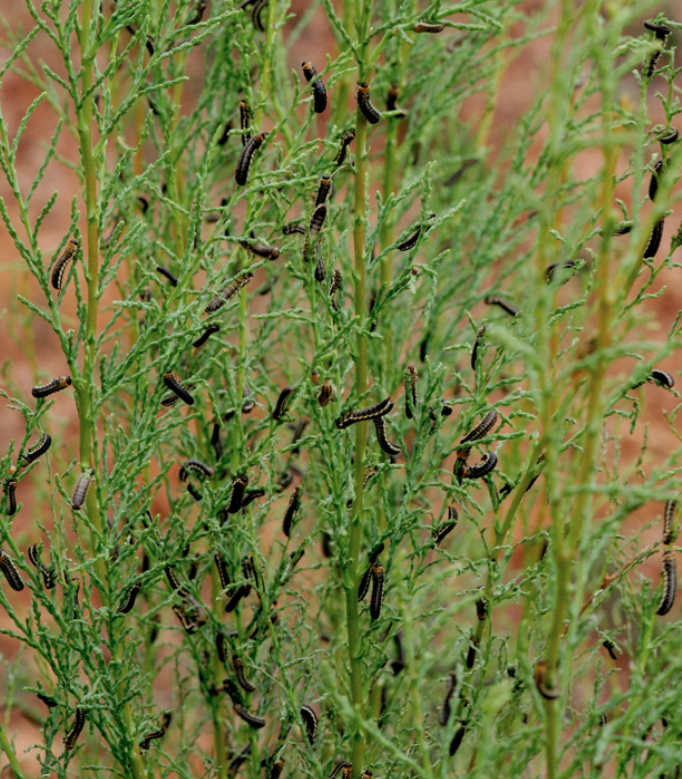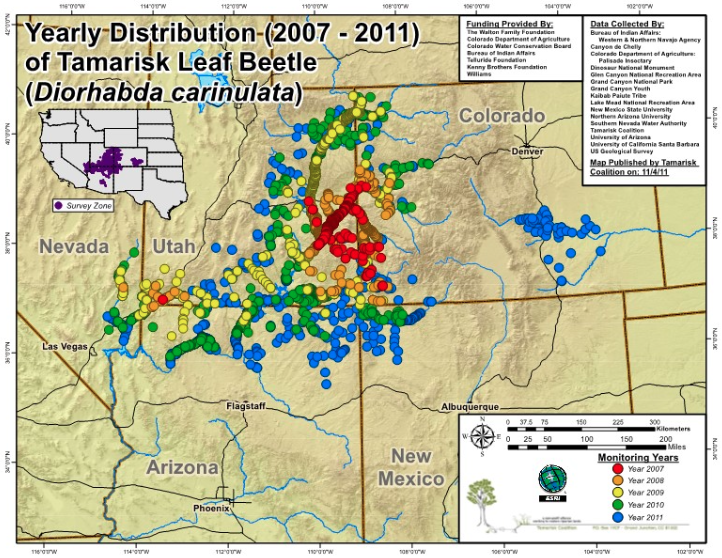To protect the Grand Canyon’s native species, resource managers have pitted one non- native species against another, though not intentionally. The tamarisk plant, a shrub native to Eurasia and Africa, has spread rapidly throughout the canyon since its introduction in the 1920s and 30s. Once prized for its ornamental quality and ability to help control erosion, tamarisk has since been identified as a pest both for its perceived excessive water use and for its displacement of native plants like willows and cottonwoods. Over the past two decades, the National Park Service has sought to eliminate tamarisk within the canyon by both physically removing the shrubs and applying herbicides. However, thanks to an experimental US Department of Agriculture program to reduce tamarisk populations in other parts of the Southwest, managers in the canyon now have an unintended ally in the fight against tamarisk: the tamarisk beetle.

As its name suggests, the tamarisk beetle eats tamarisk. Also non-native to the American Southwest, this insect serves as an example of “biocontrol,” which describes efforts to combat the spread of non-native species by either actively supporting native species or introducing additional species to remove the pests. Biocontrol has the potential to be extremely advantageous when compared with other pest control methods; limited funds are needed to introduce a new species, and no harmful chemicals need to be spread throughout the ecosystem. Success stories include that of the parasitoid wasp, which has been successfully used to eliminate pea aphids that destroy agricultural crops. At the same time, since biocontrol agents are living organisms, their deployment can also result in unintended harmful consequences. A particularly notorious example is the cane toad, introduced to Australia in the 1930s to control cane beetles that destroy sugarcane crops. The toads failed to reduce the cane beetle population, spread rapidly themselves, and ultimately only contributed to the decline of native Australian species.

Unlike the cane toad, the tamarisk beetle has been extremely successful in reducing tamarisk populations in areas where it has been introduced. The beetle only eats the leaves of the tamarisk plant, effectively reducing the shrub’s population without directly harming any other species. However, since its introduction in 2001, the beetle has spread rapidly beyond the relatively limited areas in which managers intended for it to operate. This is in large part due to the beetle being able to survive the winter in habitats farther south than previously believed. In 2009, researchers found the tamarisk beetle in Grand Canyon National Park. Although unintended, this is not necessarily an unwelcome development for the canyon, since the beetle may assist the park’s ongoing efforts to control the tamarisk population. However, the accelerated tamarisk removal brought on by the beetle poses its own set of challenges for park officials.

In particular, the southwestern willow flycatcher, an endangered bird native to the Grand Canyon and the subject of additional management programs, currently relies on tamarisk for its habitat. The threat to the willow flycatcher posed by the tamarisk beetle was the subject of a lawsuit against the USDA in 2010, halting additional introduction of the beetle. Still, the relationship between the willow flycatcher and the tamarisk beetle is not straightforward; the birds originally lived in and prefer the willows and cottonwoods the non-native shrub displaced. As a result, resource managers in the Grand Canyon are working on quickly removing dead tamarisk as it is destroyed by beetles and replacing it with native vegetation in order to minimize the impact on willow flycatchers and other species. Ultimately, the full effects of the tamarisk beetle incursion into the Grand Canyon region are not yet known.
The history of the tamarisk beetle in the Grand Canyon raises important questions about the responsible of biocontrol as a means to maintain or restore ecosystems. Is it ever possible to fully anticipate the effects of a biological agent on the environment prior to its release? Despite extensive research and testing, the tamarisk beetle still managed to move into habitats in which it should not have been able to survive. How much should humans try to meddle in natural systems, even those that they have already altered? Although the tamarisk is undoubtedly a non- native plant, its status as a pest is still disputed; some recent research has suggested it might not use substantially more water than native species, for example. It is currently unclear whether the potential benefits of the tamarisk beetle’s presence in the Grand Canyon will outweigh the danger it poses to the willow flycatcher and other species. Biocontrol has been and will continue to be an important part of a holistic system of combatting harmful species, but managers and policymakers need to keep these kinds of questions in mind when considering future biocontrol programs, even those in which all possible outcomes have supposedly been considered.
